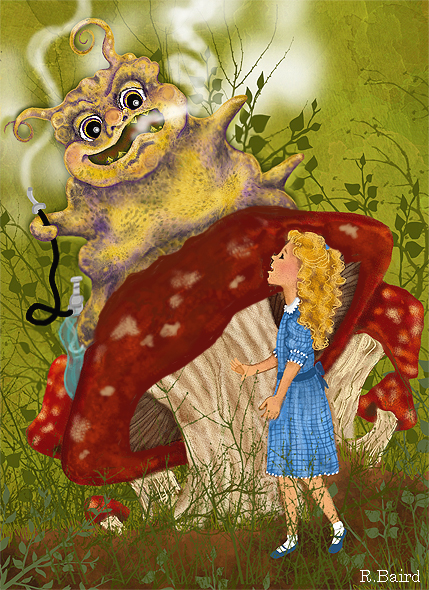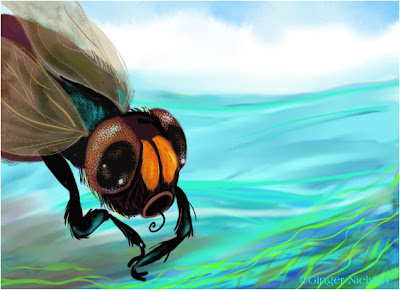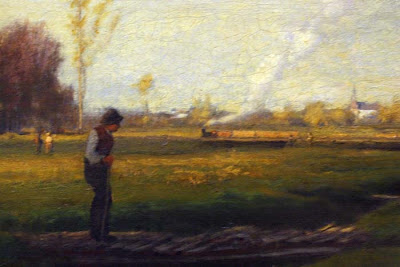![]() 0 Comments on You Are Here as of 1/1/1900
0 Comments on You Are Here as of 1/1/1900

By: Ken Baker,
on 8/17/2010
Blog: Ken Baker: Children's Author
( Login to Add to MyJacketFlap)
JacketFlap tags:
conflict, emotions, character, perspective, humanity, depth, inner self, physical attributes, outer self, character qualities, multi-dimensional, flaws, Add a tag
One of the ways of adding depth to your stories is to make sure your characters have depth. You need to go far beyond having a character with a basic set of emotions coupled with a physical description of the character.
Your character needs history. What has happened in her life to make her who she is? What’s her relationship with her parents, siblings, children, friends, bosses, teachers, and others?
No one is perfect, so your character needs flaws. How do these flaws play into the plot? Do they create additional conflict, internally or externally? Even if your antagonist is the most evil person in the world, your character needs some good qualities to show their humanity. Obviously, your protagonist needs good qualities too. Otherwise we won’t care what happens to her.
Your characters need to have inner conflicts that the people around them can’t see or don’t know about. Everyone puts on a front or a face that they show the world, which is different than how they view themselves. We need to see the discrepancies between the character’s inner self and the self they show the world. When we talk, we don’t always say what we mean—the same thing has to happen with your characters from time to time—where you know they’re thinking one thing, but saying something different. Once again it becomes the clash between the inner self and the outer self.
These are just a few things to watch out for when adding depth to your characters. Below are a few of my favorite books that provide even more valuable insights on creating characters with depth.
Characters and Viewpoint by Orson Scott Card - Provides invaluable perspectives on how to develop and use your characters to make your stories come alive.
The Comic Toolbox by John Vorhaus – While this book primarily focuses on how to add humor to your stories, it also covers many aspects of creating multi-dimensional characters in terms of their flaws, humanity, and unique perspective on the world.
Building Believable Characters by Marc McCutcheon - From listings of physical attributes to character actions and the way they dress, this is a good reference or resource book for helping you define the unique characteristics of your individual characters.
By: Lia Keyes,
on 6/10/2010
Blog: ScribeChat
( Login to Add to MyJacketFlap)
JacketFlap tags:
storytelling, point of view, POV, powers, magical, attitude, perspective, connection, Topic, Add a tag
One of the most magical storytelling tools in the novelist’s arsenal is that of point of view, or POV for short. Your choice of point of view will determine the quality of the connection your reader feels, not only to your character, but to the point you’re discussing within your story.
Who do you want the [...]
No related posts.

By: Roberta Baird,
on 2/26/2010
Blog: A Mouse in the House
( Login to Add to MyJacketFlap)
JacketFlap tags:
illustration, Illustration Friday, IF, children's illustration, alice in wonderland, digital art, roberta baird, caterpillar, artwork, a mouse in the house, perspective, coloring pages, Add a tag
per·spec·tive (p r-sp r-sp k k t t v) n. v) n.
Subjective evaluation of relative significance; a point of view.

“Are you content now?” said the Caterpillar.
“Well, I should like to be a little larger, sir if you wouldn’t mind,” said Alice: “three inches is such a wretched height to be.”
“It is a very good height indeed!” said the Caterpillar angrily, rearing itself upright as it spoke (it was exactly three inches high).
“But I’m not used to it!” pleaded poor Alice in a piteous tone. And she thought to herself, “I wish the creatures wouldn’t be so easily offended!”
“You’ll get used to it in time,” said the Caterpillar; and it put the hookah into its mouth and began smoking again.
 My perspective is pretty much the same, houses and buildings, painting and having fun. My perspective is pretty much the same, houses and buildings, painting and having fun.
My submission for Illustration Friday's "perspective" theme is a drawing I made for my dear friend artist Pam Jones. It is her birthday on Saturday February 27 and she is a fellow pisces. We belong to a music sharing blog called Kings of Maybe and I am playing her a few songs this weekend as well so if you click on you may follow along too. This drawing called "Going Up?" is her birthday card and I thought on Pam's way up she might need to bring along a few things she could use: Fishie Friends, a monster, a valpal hat to receive songs and messages and a birthday cake! of course it is chocolate :P I hope you have a fabulous birthday sweet Pam Jones! Big love from Valgal, babe!
birthday card for Pam Jones 2010

Taking a page or two from My African Bedtime Rhymes, by Brettell Hone, published by Shamwari Publishing, the first illustration shows a fly resting on the water.
Soon to be chased by two young trout he finds a safer resting place above. 
Here are two photographs from a 1903 text for artists about reflections on water.
 Left: “Knotted reflections of masts.” Right: “Broken reflection of sail. The mast, being taller, is reflected as a continuous winding line.” Left: “Knotted reflections of masts.” Right: “Broken reflection of sail. The mast, being taller, is reflected as a continuous winding line.”
The book is called Light and Water: A Study of Reflexion and Colour in River, Lake, and Sea, by Sir Montagu Pollock. It gives a thorough analysis of reflections on smooth, rippled, and wavy water, with perspective diagrams and explanations. You can download it for free as a PDF at the Internet Archive.
The 18th century buildings along the Loire river in the Île Feydeau neighborhood of Nantes, France, have tilted rather alarmingly because their foundations were laid on sandy ground.
 They dramatically illustrate a point that you can observe more subtly in almost any group of buildings or structures: Things settle a bit and get out of alignment over time. Or they weren’t built perfectly in the first place, especially before the laser-beam era. They dramatically illustrate a point that you can observe more subtly in almost any group of buildings or structures: Things settle a bit and get out of alignment over time. Or they weren’t built perfectly in the first place, especially before the laser-beam era.
When it comes to drawing a row of buildings, it is usually preferable to give them a little wobble. To do that, you can construct a whole set of slightly varying vanishing points.
When it's done very subtly, it gives architectural forms a certain naturalness and believability that beats the kind of cold rendering that comes from aligning an entire parallel facade with a single vanishing point.
(And yes! We saw the machines...more on that in a future post.)

By: Rebecca,
on 9/15/2009
Blog: OUPblog
( Login to Add to MyJacketFlap)
JacketFlap tags:
History, war, American History, A-Featured, Vietnam, Mark, World History, perspective, prophecy, Bradley, Philip, Mark Philip Bradley, Add a tag
Mark Philip Bradley is Associate Professor of History at the University of Chicago. His most recent book, Vietnam at War, looks at how the Vietnamese themselves experienced the conflicts,  showing how the wars for Vietnam were rooted in fundamentally conflicting visions of what an independent Vietnam should mean that in many ways remain to this day. In the excerpt below, from the introduction, Bradley begins to paint the Vietnamese perspective of the conflict. showing how the wars for Vietnam were rooted in fundamentally conflicting visions of what an independent Vietnam should mean that in many ways remain to this day. In the excerpt below, from the introduction, Bradley begins to paint the Vietnamese perspective of the conflict.
In the early 1990 a short story by a young author, Tran Huy Quang, entitled ‘The Prophecy’ (’Ling Nghiem’), appeared to great interest in Hanoi. It told the tale of a young man named Hinh, the son of a mandarin, who longed to acquire the magical powers that would one day enable him to lead his countrymen to their destiny. The destiny itself does not particularly concern Hinh, but he is intent upon leading the Vietnamese people to it. In a dream one evening, Hinh meets a messenger from the gods, who tells him to seek out a small flower garden. Once he reaches the garden, Hinh is told, he should walk slowly with his eyes fastened on the ground to ‘look for this’. It will only take a moment, the messenger tells Hinh, and as a result he will ‘possess the world’.
When he awakens, Hinh finds the flower garden and begins to pace, looking downward. Slowly a crowd gathers, first children, then the disadvantaged of Vietnamese society: unemployed workers, farmers who had left their poor rural villages to find work in the city, cyclo drivers, prostitutes, beggars, and orphans. Watching Hinh, they ask in turn, ‘What are you looking for?’ He replies, ‘I am looking for this.’ Hopeful of turning up a bit of good luck, they join him, and soon multitudes of people are crawling around in the garden. Hinh looks around at the crowd searching with him and believes the prophecy has been fulfilled: he possesses the world. With that realization Hinh goes home.
To Vietnamese readers the story was immediately recognized as a parable, with Hinh representing Ho Chi Minh, the pre-eminent leader of the twentieth-century Vietnam. The prophecy was seen as coming from a secular god, Karl Marx. ‘This’ was the promise of a socialist future, which the author of ‘The Prophecy’ and many of his readers in Hanoi increasingly believed to be a hollow one. For them, socialist ideals did enable Vietnamese revolutionaries to develop a mass following and establish an independent state, throwing off a century of French colonial rule. But in the aftermath of some thirty years of war against the French and the Americans, their hopes for a more egalitarian and just society appeared to remain unfulfilled.
…In truth, there were many Vietnam wars, among them an anti-colonial war with France, a cold war turned hot with the United States, a civil war between North and South Vietnam and among southern Vietnamese, and a revolutionary war of ideas over the vision that should guide Vietnamese society into the post-colonial future. The contest of ideas began long before 1945 and persists to the present day in yet another war, this one of memory over the legacies of the Vietnam wars and the stakes of remembering and forgetting them.
For most Vietnamese, the coming of French colonialism in the late nineteenth century raised profound questions about their very survival as a people and pointed to the need to rethink fundamentally the neo-Confucian political and social order upon which Vietnamese society has rested. As one young Vietnamese asked in a 1907 poem:
Why is the roof over the Western universe the broad land and skies;
While we cower and confine ourselves to a cranny in our house?
Why can they run straight, leap far,
While we shrink back and cling to each other?
Why do they rule the world,
While we bow our heads as slaves?
Throughout the twentieth century, in both war and at peace, and into the twenty-first century, the Vietnamese have searched for answers to the predicaments posed by colonialism and the struggle for independence. As they have done so, a variety of Vietnamese actors have appropriate and transformed a fluid repertoire of new modes of thinking about the future - social Darwinism, Marxist-Leninism, social progressivism, Buddhist modernism, constitutional monarchy, democratic republics, illiberal democracies, and market capitalism to name just a few - to articulate and enact visions for the post-colonial transformation of urban and rural Vietnamese society. But the end of the Vietnam wars did not bring a final resolution to these competing visions. When North Vietnamese tanks entered Saigon on 30 April 1975 to take the surrender of the American-backed South Vietnamese government, Vietnam was reunified as a socialist state. The long war for independence was over. Yet even today, as the searchers in ‘The Prophecy’ suggest, the meanings according to ‘running straight and leaping far’ remain deeply contested. In one of many present-day paradoxes, the Vietnamese state seeks to develop a market economy as it maintains its commitment to socialism, while an increasingly heterodox Vietnamese civil society simultaneously embraces the global economy, years for the unfulfilled promises of socialist egalitarianism, and reinvents many of the spiritual and familial practices the socialist state spent the war years trying to stamp out. Indeed, a walk today through a typical city block at the centre of Hanoi or Saigon, a block in which a refurbished Buddhist temple might be flanked by a Seven-Eleven store on one side and the local community party headquarters on the other, quickly reveals these everyday contradictions and tensions…
 

 Focal Press have given us permission to reprint a few lessons from their great new book, Drawn to Life: 20 Golden Years of Disney Master Classes, Volume 2: The Walt Stanchfield Lectures. Check out the first lesson on Perspective Drawing here. Here’s the second lesson on figure drawing in perspective… Enjoy! Focal Press have given us permission to reprint a few lessons from their great new book, Drawn to Life: 20 Golden Years of Disney Master Classes, Volume 2: The Walt Stanchfield Lectures. Check out the first lesson on Perspective Drawing here. Here’s the second lesson on figure drawing in perspective… Enjoy!
Walt Stanchfield:

Isn’t this a beauty! Of course, you’d have to go out of your way to draw something so third dimensionally screwed up. Even a non-artist could come closer to reality than that, because a box is a relatively simple form.
A box takes place in space, and as we draw it, it’s easy to think of it as occupying space, especially with the help of some elementary perspective.

The human (or animal) shape exists also in space and, though much more complicated, the idea of it displacing space is the same. However, quite often when drawing from a model we switch into a different mode than when drawing a box. With a box, it’s easy to see the space inside and around the shape, but with the more complicated human figure that aspect is not so obvious.
Let’s try to establish a clear concept of seeing the figure in space by using what might be called the “shock treatment.” Here is a screen with a 2-dimensional shadow of a figure cast on it.

Now the screen is suddenly pulled away and there before us, without 3D glasses, is the same figure in glorious 3D. (Drawing by 3D advocate, Mike Swofford; modeled by third dimensional Allison Mosa.)
Look from drawing to drawing and you can see it happen. That gratifying and fascinating realization of 3D that overwhelms you — which should be your normal realization at all times while drawing.
Superimposing the box onto the figure illustrates how they both relate to space in a similar way.

Also of interest:
Download the rest of this tutorial (PDF)
20 Golden Years of Disney Master Classes, Volume 2: The Walt Stanchfield Lectures (Amazon)
Perspective Drawing Lesson by Walt Stanchfield
Architecture students at the École des Beaux-Arts in Paris studied the proportions and the ornament of Greek and Roman buildings, and they became masters at rendering them in ink and watercolor.
 The winners of of the Prix de Rome competition were sent to Rome at government expense to do extensive studies of famous monuments. They periodically sent back drawings showing ornamental details, reconstructed facades, or perspective scenes of famous vistas, like the Forum or the Acropolis. The winners of of the Prix de Rome competition were sent to Rome at government expense to do extensive studies of famous monuments. They periodically sent back drawings showing ornamental details, reconstructed facades, or perspective scenes of famous vistas, like the Forum or the Acropolis.

Artists adhered to particular conventions for representing architectural forms. The light had to come from the left at a 45-degree angle. Values lightened systematically as they went back in space. (Above: Constant Moyaux, Below: Normand, 1852)
 Students developed concepts in relatively loose sketches. Then they began the presentation drawings in line, usually in grayed-down India ink, with a series of very light washes of tone to build up the modeling gradually so that the tones seemed to reside in the paper rather than being superimposed over it. Students developed concepts in relatively loose sketches. Then they began the presentation drawings in line, usually in grayed-down India ink, with a series of very light washes of tone to build up the modeling gradually so that the tones seemed to reside in the paper rather than being superimposed over it.
------------
There’s an affordable book from Dover that reprints in black and white a famous set of prints assembled by Hector d’Espouy, link.
Wikipedia on Beaux-Arts Architecture, link.
Why do the railroad cars in this painting by George Inness (1825-1894) appear to be size of refrigerator cartons?

1. The top of the engine’s smokestack is even with the man’s nose, which makes the top of the boxcars—and our eye level—about four feet above the ground.
2. The train can’t be any lower than the man because we can see the man is crossing a small stream, and a stream is always the lowest part of a meadow.
3. The train seems to be about as far away as the tall yellow tree. If the tree is about 60 feet average height, then each train car, by comparison, would be just a few feet long. (A passenger car on a mid-19th century train would be about 60 feet long, and a boxcar about 40 feet long, link).
4. The church at the far side of the meadow appears to be about 30 feet tall at the top of its nave. Given that the train is about a third of the way between us and the church, that makes the engine about 10 feet long.
 If Mr. Inness wanted to show the train in proper scale to the scene, it would have to be tall enough to nearly block the view of the town. If Mr. Inness wanted to show the train in proper scale to the scene, it would have to be tall enough to nearly block the view of the town.
If he wanted to keep the train small for artistic effect, he'd have to do two things: put the man on a hillock at the edge of the valley, rather than on a footbridge, and scale down the nearby trees and the far town.
The point here is that perspective operates all the time, not just with architectural subjects.
------
The painting is called "Short Cut, Watchung Station, New Jersey," 1883, in the Philadelphia Museum.
Related GJ posts on Eye Level, part 1, part 2, and part 3.
I'm there!
3rd Annual Los Angeles International
Tamale Festival
at "The tamales capital of the world"
MacArthur Park - Mama's Hot Tamales Café
(2124 West 7th Street, Los Angeles, CA 90057
between Parkview & Alvarado Street on 7th Street)
FREE ADMISSION
November 9, 10 & 11, 2007
Friday: 3pm - 8pm
Saturday:10am - 9pm
Sunday 11am - 6pm
Best Tamale Contest Tamale Eating Contest Biggest Tamale Contest
Tamale Making Demo Non-profit Booths Commercial Booths Art & Crafts
Booths Kids Zone
Entertainment Schedule:
Friday
3:00 P.M. Perdy Montes
4:30 P.M. Emilio Tejeda
5:00 P.M. Banda Sinaloense Los Angelinos
5:30 P.M. Sol Latino
6:10 P.M. Fama Nortena
6:45 P.M. Ruben dela Cruz
7:30 P.M. Juan Carlos "La imagen de Juan Gabriel"
8:00 P.M. Closed
Saturday
10:00 A.M. Juan Elizulde
10:30 A.M. Julio Molina
11:00 A.M. Natalie Reyes
12:00 Noon Alan Reyes
1:00 P.M. Best Tamale Contest - Stage
2:00 P.M. Rosy Gonzales
3:00 P.M. Rico Mago
4:00 P.M. Rock en Espanol
5:00 P.M. Sangre Fria
6:00 P.M. Gustavo VII
7:00 P.M. Yaky La Indomable
8:00 P.M. Alerta 3
9:00 P.M. Closed
Sunday
11:00 A.M. Danza Folklorico Netzahaul
12:00 Noon - Stage Honoring all Veterans
1:00 P.M. Tamale Eating Contest
2:00 P.M. Sangre Fria
3:00 P.M. Ballet Folklorico Azatlan
3:30 P.M. Lupita Fernandez
4:00 P.M. Lenny Lopez y su lluvia Tropical
4:30 P.M. Los Ases del Tamboraso
5:00 P.M. Pateles Verdes
6:00 P.M. End of Event
|

















 r-sp
r-sp k
k t
t v)
v) 













Thanks for this post. Although not published, I did just recently complete my first and have started a second book. I have caught myself staring at the words and thinking many of these same things. I might not need an attitude adjustment, but perhaps a perception adjustment is in order.